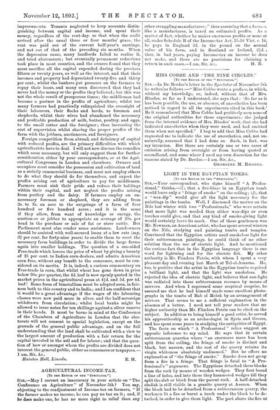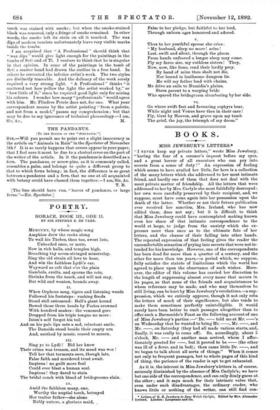LIGHT IN THE EGYPTIAN TOMBS.
[To THE EDITOR OF THE " SPECTATOR:]
SIR,—Your correspondent, who signs himself "A Profes- sional," thinks,—(1), that a fire-blaze in an Egyptian tomb would leave only a "fringe of smoke" on the ceiling ; (2), that a " wax-dip " would give all the light necessary for the paintings in the tombs. Well, I discussed the matter on the Nile last winter with two "Professionals," who were certain that more light was needed than either wax-dips or even torches could give, and that any kind of smoke-giving light would certainly leave its mark. One of these gentlemen was Mr. Newman, an American artist, who has spent several winters on the Nile, studying and painting tombs and temples. Convinced that the Egyptian artists used smokeless light for their subterranean paintings, he could think of no other solution than the use of electric light. And he mentioned the curious fact that in the Egyptian language there is one word for lightning and for the electric fish. My other authority is Mr. Flinders Petrie, with whom I spent a very pleasant day and evening last March at Tel-el-Aunarna,. He, too, is positive that the artist in the Egyptian tombs required a brilliant light, and that the light was smokeless. He rejected the idea of electric light, and believes that sun-light was radiated into those subterranean recesses by means of mirrors. And when I expressed some sceptical surprise, he assured me that he had himself made some excellent photo- graphs in the tombs of Bab el Meluk by an arrangement of mirrors. That seems to me a sufficient explanation in the absence of a better. I need not tell your readers that no higher authority than Mr. Flinders Petrie can be cited on the subject. In addition to being himself a good artist, he served his apprenticeship as an archmologist in Syria and Greece, and has spent some years in studying the antiquities of Egypt.
The facts on which "A Professional" relies suggest an opposite inference to my mind. He says that in certain subterranean quarries where "an enormous mass has been split from the ceiling, the fringe of smoke is distinct and black, but narrow, and the rest of the quarry retains its virgin whiteness absolutely undimmed." But he offers no explanation of "the fringe of smoke." Smoke does not go up from a fire in a fringe. That fringe is fatal to "A Pro- fessional's" argument. The Egyptians detached these blocks from the rock by means of wooden wedges. They first bored a line of holes, and into these they hammered wedges till they split the slab or block from the parent rock. A half-detached obelisk is still visible in a granite quarry at Assuan. When the block had to be detached from a subterraneon quarry, the workmen lit a fire or burnt a torch under the block to be de- tached, in order to give them light. The part above the fire or torch was stained with smoke ; but when the smoke-stained block was removed, only a fringe of smoke remained. In other words, the smoke left its stain on all it touched. The wax dips of modern tourists unfortunately leave very visible marks inside the tombs.
. I am surprised that "A Professional" should think that ",wax dips" would give light enough for the paintings in the tombs of Seti and of Ti. I venture to think that he is singular in that opinion. In some of the paintings in the tomb of Seti a master hand had drawn the outline in a free hand. In others he corrected the inferior artist's work. The two styles are distinctly traceable. And the delicacy of the work surely required a very strong light. "A Professional" thinks "it mattered not how yellow the light the artist worked by," or "how little of it," since he required good light only for mixing his colours. I wonder how many "professionals "would agree with him. Mr. Flinders Petrie does not, for one. What your correspondent means by the artist painting "from a palette, and not from a model," passes my comprehension ; but that may be due to my ignorance of technical phraseology.—I am,







































 Previous page
Previous page